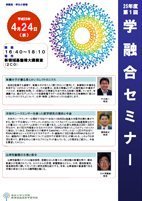AY2013 1st Gakuyugo Seminar
- Date&Time:
- Apr 24, 2013 16:40~18:10
- Venue:
- Large Lecture Room (2C0), New Frontier Science Bldg.

Soft electronics created by organic molecules
Professor Junichi Takeya
In the process of drying the solution, it has been discovered that the organic molecules quickly and neatly align to form organic semiconductors. The result is a technology that allows us to create semiconductor devices with much higher performance than previously thought, using organic materials and simple methods such as printing. In this lecture, we will introduce topics in chemistry, physics, and engineering on "soft electronics" of organic materials, which are expected to be applied to bendable displays and low-cost electronic tags.

Current and future medical research using next-generation sequencers
Professor Sumio Kanno
Next generation sequencers can currently read about 600G bases of raw sequence per machine in 10 days. This is enough to determine the genomes of 3-4 people, since the human genome is only about 3Gbases, even though it is a short and inaccurate sequence. The cost of the array is approaching the cost of the array at the beginning of GWAS, although it still costs about 800,000 yen, since the consumables required for this are 2 to 3 million yen. Exome sequencing, which analyzes only the exon portion, costs less than 200,000 yen per person, and RNA analysis costs 30,000-40,000 yen to obtain 20 million tags of data (if there are 1 million mRNAs in a cell, 20 tags can be expected for each RNA in the cell). ) can be obtained. In response to this situation, various projects are underway, especially in medicine. I would like to introduce this current situation and look into the future.

Ecology and conservation of coastal cetaceans
Professor Kunio Shirakihara
The population of the coastal cetacean, Pacific white-snappers, is in danger of declining due to the effects of various human activities such as sand extraction and bycatch. In this paper, we present the results of our research on the distribution, population estimation, and use of port areas based on visual and acoustic surveys from a Cessna. Issues related to the conservation of this common coastal species will be discussed.

